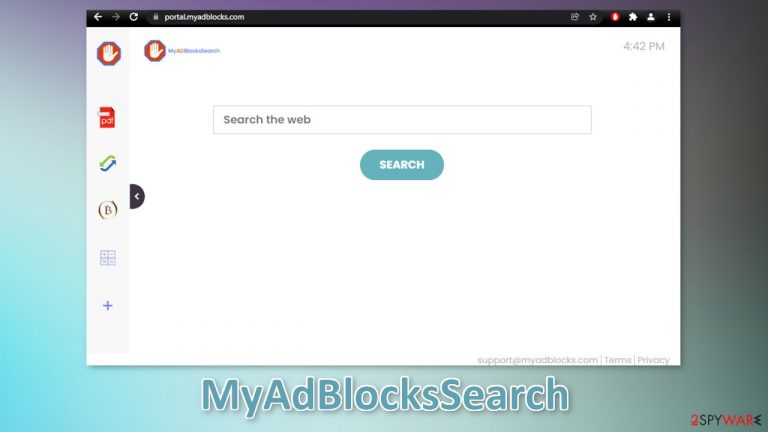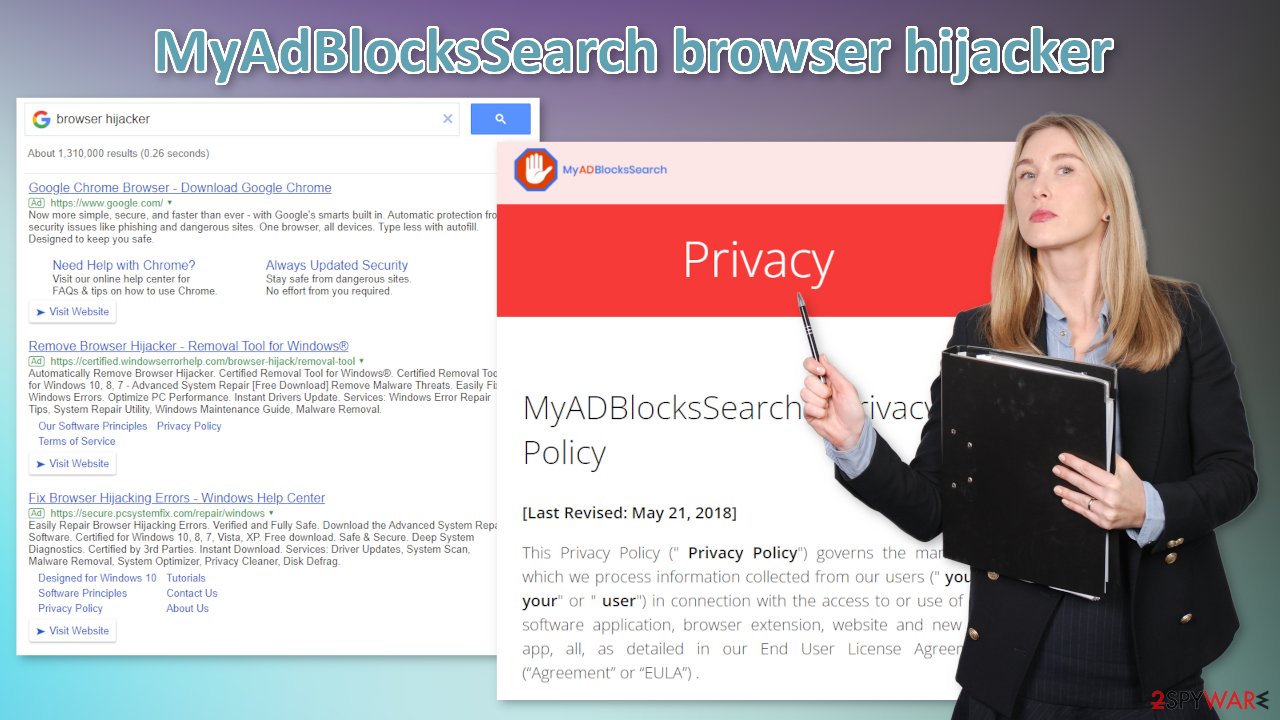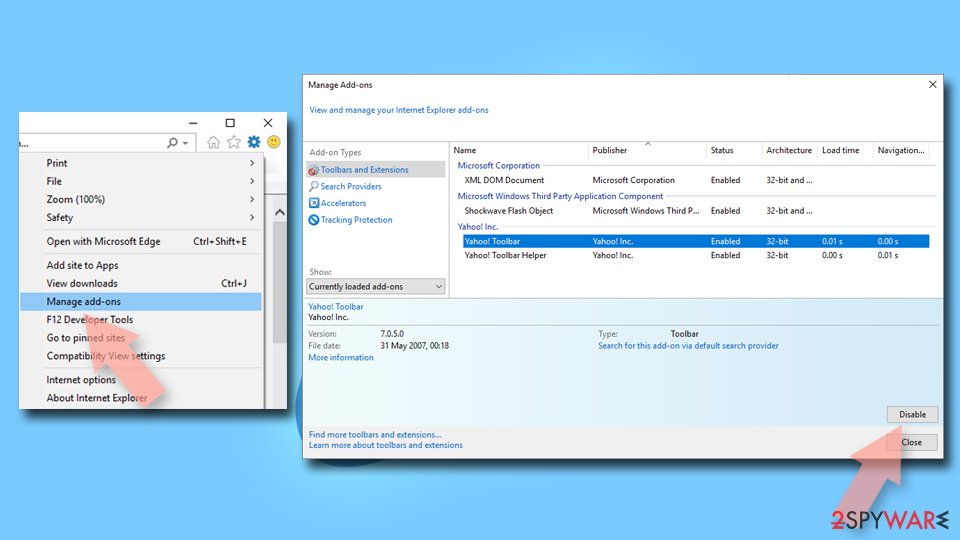MyAdBlocksSearch browser hijacker (virus) - Chrome, Firefox, IE, Edge
MyAdBlocksSearch browser hijacker Removal Guide
What is MyAdBlocksSearch browser hijacker?
MyAdBlocksSearch changes your search engine to an untrustworthy one placing your security at risk

MyAdBlocksSearch is a browser hijacker that changes the main settings, like the homepage, new tab address, and search engine. Once it infiltrates the machine, the app can force users to browse only through selected channels, inject ads in the search results, cause pop-ups, redirects, banners, and other commercial content.
Because the developers of such applications create them only for profit, they do not care about user privacy or security. The extension may cause you to end up on dangerous pages that use social engineering techniques to trick you into providing your personal information or installing PUPs (potentially unwanted programs)[1] or malware.
Even though the name implies that the extension should block ads, that is not the case. The plugin does not provide any benefits for the user. It only has a few basic functions that are available on any browser with a click of a button anyways – a PDF file converter, calculator, currency converter, and an ability to save favorite websites.
| NAME | MyAdBlocksSearch |
| TYPE | Browser hijacker; potentially unwanted program |
| SYMPTOMS | The main settings of the browser like the homepage, new tab address, and search engine get changed |
| DISTRIBUTION | Shady websites, deceptive ads, freeware installations |
| DANGERS | The app can lead to misinformation, and collect user browsing-related data |
| ELIMINATION | Remove the plugin via browser settings |
| FURTHER STEPS | Use a maintenance tool FortectIntego to fix any remaining damage and optimize the machine |
MyAdBlocksSearch in detail
There are hundreds of browser add-ons that look exactly the same and do the same things. This extension belongs to a huge browser hijacker family which the creators of are unknown. We have previously written about hijackers like GoAdblockSearch, TopAdblockSearch, and WebAdblockSearch. As you can see, even their names are very similar.
Over the past few years, we have seen an increase in apps that take over the browsing experience. They are very easy to reproduce and require very little effort to distribute, once the looks and usability are sorted out. All the developers need to do is distribute them through software bundling,[2] deceptive ads, and they can collect revenue from PPC advertising.[3] If you experience these symptoms, your browser has been definitely hijacked:
- Your browser's homepage gets changed to portal.myadblocks.com
- Your web browser’s default search engine is now Yahoo, Searchlee, Bing or Nearbyme
- Your browser’s search queries are redirected through feed.myadblocks.com
- The MyAdBlocksSearch browser extension or program is installed on your computer
Browser hijackers rarely have their own search engines. The creators usually implement already existing ones just to make them functional. Although Bing and Yahoo are well-known search engines used by many people around the world, the other ones are not.

You may start seeing promotional links injected in the search results, random redirects taking you to shady pages, and an overall increase in commercial content. But that is not the only way that hijackers can monetize user activity. Extensions can use cookies to track users' browsing activity, like the websites they visit, links they click on, and things they purchase. This information can later be sold to advertising networks that use it to target you with ads even more.
Remove the extension affecting your browser
The first thing you should do is go to your browser settings and check if you see MyAdBlocksSearch in the list, any extensions with a similar name, or suspicious-looking add-ons in general. You can follow our guide if you need help:
Google Chrome
- Open Google Chrome, click on the Menu (three vertical dots at the top-right corner) and select More tools > Extensions.
- In the newly opened window, you will see all the installed extensions. Uninstall all the suspicious plugins that might be related to the unwanted program by clicking Remove.

MS Edge:
- Select Menu (three horizontal dots at the top-right of the browser window) and pick Extensions.
- From the list, pick the extension and click on the Gear icon.
- Click on Uninstall at the bottom.

MS Edge (Chromium)
- Open Edge and click select Settings > Extensions.
- Delete unwanted extensions by clicking Remove.

Mozilla Firefox
- Open Mozilla Firefox browser and click on the Menu (three horizontal lines at the top-right of the window).
- Select Add-ons.
- In here, select unwanted plugin and click Remove.

Safari
- Click Safari > Preferences…
- In the new window, pick Extensions.
- Select the unwanted extension and select Uninstall.

Internet Explorer:
- Open Internet Explorer, click on the Gear icon (IE menu) on the top-right corner of the browser
- Pick Manage Add-ons.
- You will see a Manage Add-ons window. Here, look for suspicious plugins. Click on these entries and select Disable.

We suggest using FortectIntego maintenance tool to clear your browsers and to completely get rid of any remaining damage. This software is capable of getting rid of cookies and cache that are used to follow you around on the Internet. It can also optimize your device and improve performance by deleting all junk files that you do not need. But this is not a single-use program. It can fix much more complicated problems like system errors, corrupted files, registry issues, and BSoDs which is especially useful after virus infections.
Scan the system to detect adware
The hijacking could have been caused not only by a browser extension but also by a PUP. If the previous removal method did not get rid of unwanted symptoms, this step should fix it. Adware usually hides in the background of the machine performing unwanted tasks sneakily. Many users do not know about the infection until they start experiencing unpleasant symptoms.
Most times adware gets installed by users unknowingly from freeware distribution sites. Because they do not make any money from giving away software for free, they include additional programs in the installers. Many users find the installation process boring so they skip through the steps and do not notice the additional files.
If you want to avoid this in the future, always choose the “Custom” or “Advanced” installation method, read the Privacy Policy and Terms of Use to find out what the program will be able to do in your machine and what data will it collect. The most important part is to look at the file list and untick the boxes next to those that seem unrelated or suspicious. But the best defense will always be to get your software from official sources.
Identifying the program responsible for hijacking your browser might be difficult if you have never done this before and if it is not named the same as the browser extension. It could be disguised as an antivirus suite, image editing software, media player, system optimizer, or anything else. PUA developers often disguise their products as handy tools so that users would not suspect them of any harm.
If you are not sure what to do and you do not want to risk eliminating the wrong files, we suggest using SpyHunter 5Combo Cleaner or Malwarebytes security tools that will scan your machine, eliminate it, and prevent such infections in the future by giving you a warning before a malicious program can make any changes. If manual removal is what you prefer, we have instructions for Windows and Mac machines:
Windows 10/8:
- Enter Control Panel into Windows search box and hit Enter or click on the search result.
- Under Programs, select Uninstall a program.

- From the list, find the entry of the suspicious program.
- Right-click on the application and select Uninstall.
- If User Account Control shows up, click Yes.
- Wait till uninstallation process is complete and click OK.

Windows 7/XP:
- Click on Windows Start > Control Panel located on the right pane (if you are Windows XP user, click on Add/Remove Programs).
- In Control Panel, select Programs > Uninstall a program.

- Pick the unwanted application by clicking on it once.
- At the top, click Uninstall/Change.
- In the confirmation prompt, pick Yes.
- Click OK once the removal process is finished.
Mac:
- From the menu bar, select Go > Applications.
- In the Applications folder, look for all related entries.
- Click on the app and drag it to Trash (or right-click and pick Move to Trash)

To fully remove an unwanted app, you need to access Application Support, LaunchAgents, and LaunchDaemons folders and delete relevant files:
- Select Go > Go to Folder.
- Enter /Library/Application Support and click Go or press Enter.
- In the Application Support folder, look for any dubious entries and then delete them.
- Now enter /Library/LaunchAgents and /Library/LaunchDaemons folders the same way and terminate all the related .plist files.

How to prevent from getting browser hijacker
Access your website securely from any location
When you work on the domain, site, blog, or different project that requires constant management, content creation, or coding, you may need to connect to the server and content management service more often. The best solution for creating a tighter network could be a dedicated/fixed IP address.
If you make your IP address static and set to your device, you can connect to the CMS from any location and do not create any additional issues for the server or network manager that needs to monitor connections and activities. VPN software providers like Private Internet Access can help you with such settings and offer the option to control the online reputation and manage projects easily from any part of the world.
Recover files after data-affecting malware attacks
While much of the data can be accidentally deleted due to various reasons, malware is one of the main culprits that can cause loss of pictures, documents, videos, and other important files. More serious malware infections lead to significant data loss when your documents, system files, and images get encrypted. In particular, ransomware is is a type of malware that focuses on such functions, so your files become useless without an ability to access them.
Even though there is little to no possibility to recover after file-locking threats, some applications have features for data recovery in the system. In some cases, Data Recovery Pro can also help to recover at least some portion of your data after data-locking virus infection or general cyber infection.
- ^ Unwanted software. Microsoft. Documents.
- ^ James Sanders. Software bundled by OEMs an increasing security concern: How to reduce your risks. TechRepublic. Cybersecurity News.
- ^ Pay-per-click. Wikipedia. The Free Encyclopedia.
